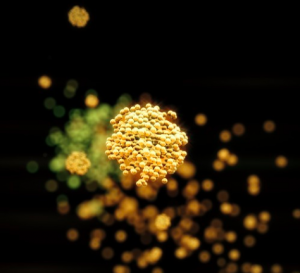Researchers at the University of British Columbia have accomplished a highly complicated reaction involving the lightest hydrogen and nano-scale gold particles (AuNPs), which may lead future research into the bizarre realm of the muonium-AuNP system.

A Moun. Source: flickr
Muon, an approximately 200 times heavier-than-usual electron, along with another electron, makes up Muonium. Muonium is a hydrogen derivative withs only one-tenth of the normal hydrogen mass. This unusual species has a half-life of 2 μ-seconds, ceasing to exist in less than a blink of eyes, which made analysis extremely difficult. Many of its applications remain as mysteries.
Gold nanoparticles (AuNPs) are sols –––– very small solid particles –––– of gold immersed in a fluid. They exhibit extraordinary optical properties that make them suitable for cancer detection. AuNPs are also the best transporters for cancer drugs inside the human body due to their tiny size and non-toxic nature.

Gold Nanoparticles absorbing light at different wavelengths. Source: Sigma-aldrich
In Chemistry, AuNPs are great heterogeneous catalysts––––reaction accelerators that differ in phase from the reactants. For example, a metallic solid speeding up the reaction of two liquids is considered a heterogeneous catalyst. These solid catalysts all together account for 90% of the catalysts used worldwide.
However, the reaction of AuNPs requires particles to be isolated from each other. In previous studies, this was achieved by “capping” gold with “long tail” chemicals to prevent interactions. But these “tails” would ultimately change the reactivity of the AuNP.

Gold nanoparticle
Source: flickr
Study into Muonium and uncapped AuNP would allow closer examination into the catalyzing properties of these unnatural species, enabling not only a basis for quantum mechanical calculations but also further exploitation of their biomedical benefits.
Researchers under the Fleming and MacFarlane group was the first in history to conduct an experiment on the reaction of Muonium and size-varying uncapped AuNP in a porous silica environment. In addition, they examined the catalyzing behavior of AuNP on muon’s reaction with surface-absorbed benzene, creating a benzene-radical.
Fleming and MacFarlane’s group successfully demonstrated the catalyzing effect of gold nanoparticles. They found that the binding energy of benzene was considerably weaker on the AuNPs than on bulk gold metal surfaces.
The results of this avant-garde reaction of Muonium coincided with many theoretical quantum calculations, bringing theoretical hypothesis into practicability. After successfully observing the reaction parameters of the Muonium and AuNP system, “Future studies of surface-absorbed reactants by the μSR technique described herein…are planned,” the authors Proposed.
